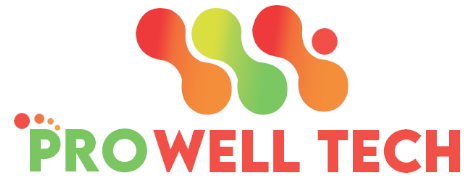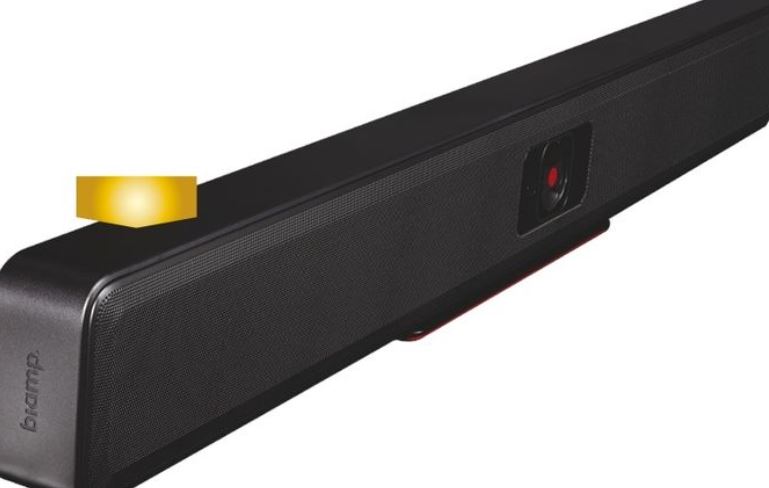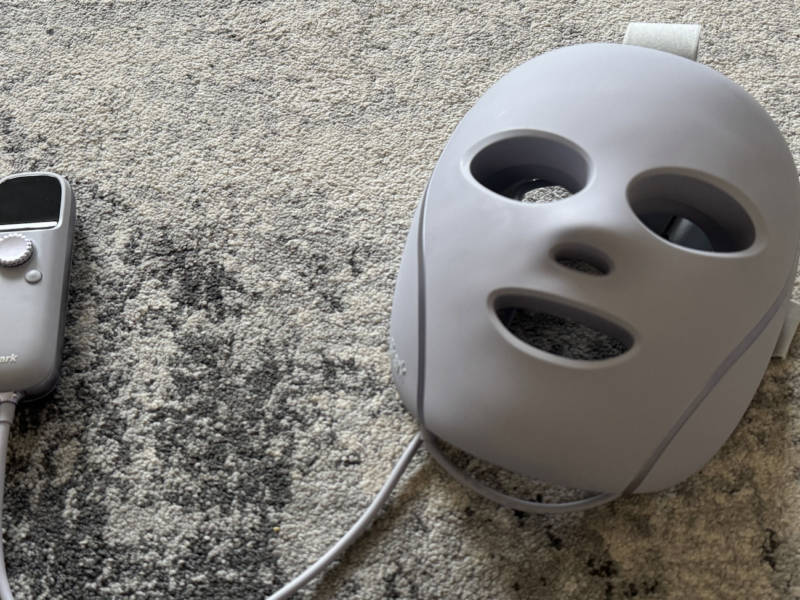Contents
- 1 Onyx Boox Palma 2 Review: The Best E-Ink Companion Ever for an E-Ink Lover
- 2 Design and Form Factor: A Marriage of Portability and Ergonomics
- 3 Differences and Comparison between Dimensions and Weight
- 4 Performance and Software Ecosystem: Harnessing Power through Android
- 5 The E-Ink Display: Clarity, Responsiveness, and Eye Comfort
- 6 The Four Cares: Eye Comfort Features: Read Without Straining
- 7 Power and Portability: A Trade-Off Between Battery Life and Features
- 8 What Could Be the Strengths or Weaknesses of the Imagined Onyx Boox Palma 2?
- 9 Final Thoughts: A Specialized Device That Is Ideal for Fans of E-Ink
Onyx Boox Palma 2 Review: The Best E-Ink Companion Ever for an E-Ink Lover
Intro: Compact E-Ink Readers Are A Small Niche
And that market is well-established for users looking for a dedicated device for digital reading — offering some benefits over traditional tablets or smartphones, like eye comfort and battery longevity. Mainly taking advantage of electrophoretic ink (E-Ink) technology according to their purpose and gaining tremendous popularity among book lovers aiming for distraction-free reading. The world of e-readers has changed over the years, leading to multiple form factors and feature sets. However, one of the most noticeable trends has been the rise of small e-readers, devices with about the same volume and aspect ratio as a contemporary smartphone. This sub-category is targeted to a particular part of the crowd: people I will call ultra-portables who need to be able to read something without the distractions that come on devices that need to do it all.
The Onyx Boox Palma series is an essential player in this growing niche. With the original Palma, Onyx delivered a device that attempted to merge the pocketable nature of a phone with the base advantages you get from an e-ink display. Now, the Onyx Boox Palma 2 is building up hype surrounding its successor. We are going to take a deeper look at what we know so far, performance, features, comparisons, and whether this can be a serious e-reading option for you if you are a fan of e-ink and reading on the move. Such devices are becoming more common, as they provide users with dedicated spaces for doing things — like reading — and the compact e-reader is one option in that digital literature space.
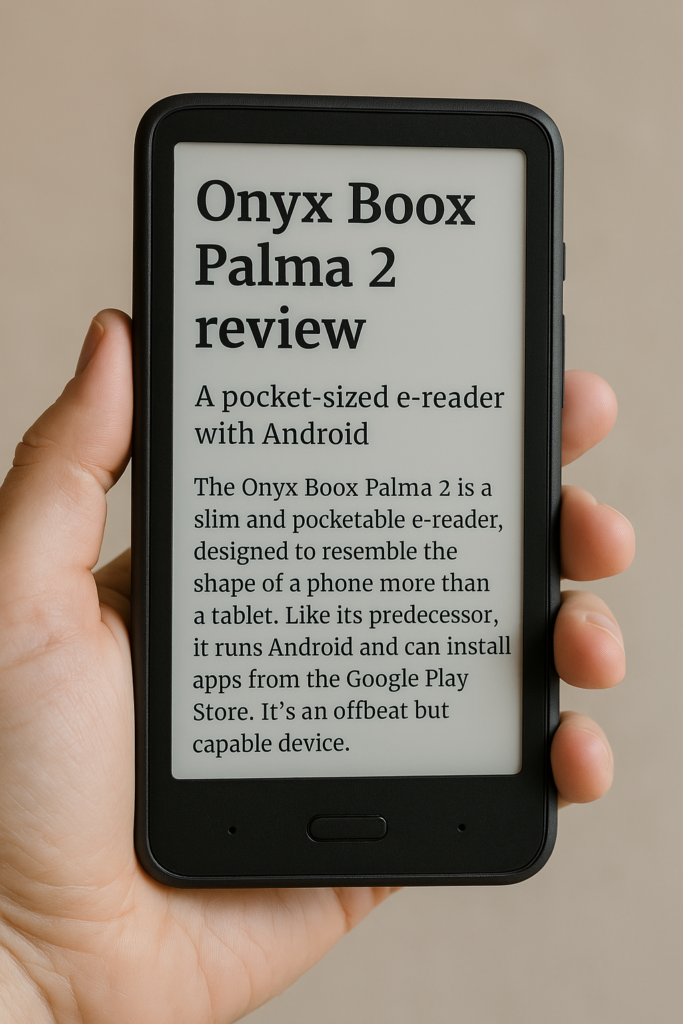
Design and Form Factor: A Marriage of Portability and Ergonomics
2.1 Size and Weight: Truly Pocketable?
Dimensions of the Onyx Boox Palma 2 will reportedly be 159 x 80 x 8.0 mm with a weight of around 170 grams. Based on its predecessor, the original Onyx Boox Palma, which measures 6 x 3 x 0.3 inches. Weight is one area where the original Palma’s specifications don’t quite match up: there are several discrepancies between sources on the net — one source reports the Palma weighed 360 grams, but this is likely a mistake, and PageStyle’s comparison seems to be around lyric-gram weight in the range of 170 grams. So this acts as a good reminder why you should always confirm specs from multiple sources.
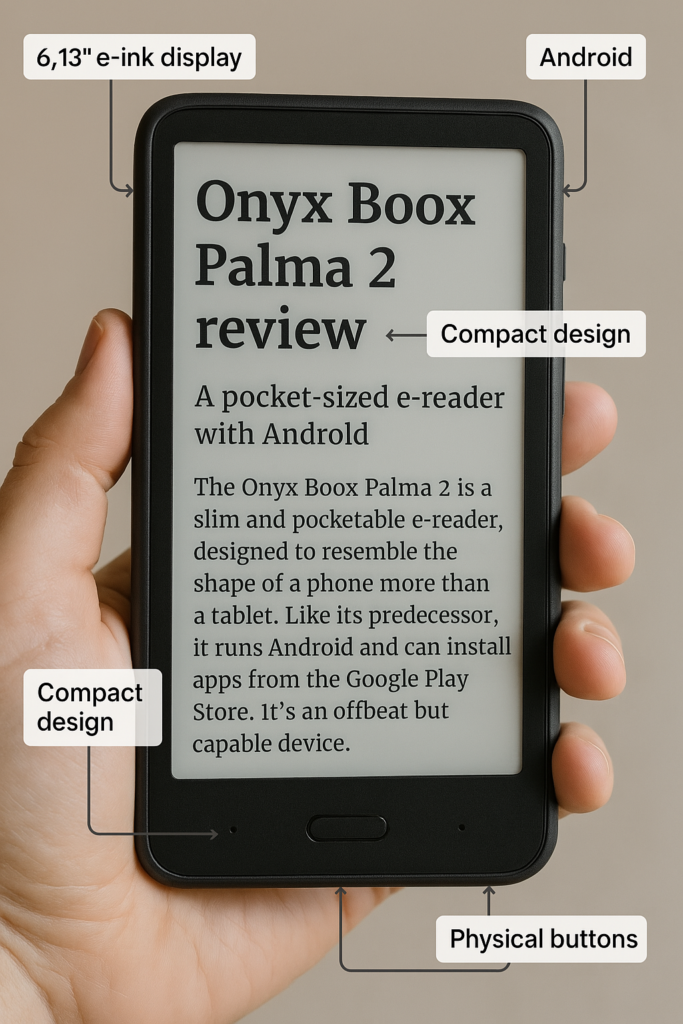
It’s worth noting that the original Palma is said to be the same size as an iPhone 15 Plus, which is a pretty standard size for smartphones. In contrast, a traditional e-reader such as the Kindle Paperwhite (2024) measures 127.6 x 176.7 x 7.8 mm and weighs 211 grams, showing the compact nature of the Palma 2. It’s much shorter and a bit narrower — but also a little thicker — and significantly lighter than the Paperwhite. Another option in the compact e-reader market is the Hisense A9, which is 159 x 79.5 x 7.8 mm and 185g. Dimensionality-wise, the Palma 2 is virtually the same size as the A9, with an almost negligible weight difference.
However, a closer examination of the Palma 2’s dimensions and weight reveals its true pocketability. Its form factor is closer to (though slightly larger than) that of a smartphone, so it should easily fit into a pocket or smaller bag as opposed to larger, traditional e-readers. This is truly a defining feature of what makes it unique and appeals directly to readers on the go. The Palma is the same size and weight as the Palma 2, which shows the conscious design decision to keep this ultra-portable format.
Differences and Comparison between Dimensions and Weight
Dimensions and Weight Comparison
| Device | Dimensions (L x W x T) | Weight (g) |
|---|---|---|
| Onyx Boox Palma 2 | 159 x 80 x 8.0 mm | ~170 |
| Onyx Boox Palma | ~152 x 76 x 7.6 mm | ~170 |
| Kindle Paperwhite (2024) | 127.6 x 176.7 x 7.8 mm | 211 |
| Hisense A9 | 159 x 79.5 x 7.8 mm | 185 |
Note: Original Palma dimensions have been converted from inches to approximate.
2.2 Materials & Build Quality: Treading The Line Between Feel and Durability
According to the review of the original Onyx Boox Palma, one of the featured specs is its mostly plastic build with a textured back that aims to improve grip. It’s functional in the sense that the textured material helps prevent slippage (and fingerprints), but it can feel “plasticky” in a way that some other devices don’t. However, the buttons are said to be metallic and might offer a more premium tactile experience. Even with its functional design, a few end users had encountered screen breakage and were worried over the original Palma’s fragility. The white version of the Palma has also been mentioned as a little scratch-prone.
The Onyx Boox Palma 2 seems to follow an identical design language, featuring a plastic body with extremely rounded sides and a gritty back cover to make finding a firm grip easier. This improved display glass is somewhat less reflective, which I think is a great attribute if you want to read the screen in various lighting situations. But it does improve scratch resistance, which is why we recommend a screen protector, so it may be more vulnerable.
By contrast, the Kindle Paperwhite (2024) has a plastic back, which is said to be slippery. Perhaps the biggest difference between Kindle and Palma is the IPX8 waterproof ratings we get from Kindles — a level of durability and peace of mind Palma doesn’t officially offer. While the Hisense A9 is said to be built in a premium chassis with some aluminium parts. However, its casing is said to be slippery, which may affect grip.
The Palma series goes for light and secure in its design philosophy, both of which are necessary characteristics in a portable reading device. On the flip side, this emphasis on function may render a less premium experience compared to something like a Hisense A9. While user feedback about the original Palma’s fragility is something to keep in mind if you’re thinking about buying a Palma 2. However, a possible drawback regarding scratch resistance means it will require careful use — or a screen protector. Unlike the Kindle Paperwhite, there is no IPX rating in the Palma series for water resistance, which is a major factor to be considered in case of accidental water exposure.

2.3 Screen and Technology: Reading Optimization with the Screen Size
Onyx Boox Palma 2 specs: The 6.13-inch HD Carta1200 glass screen has a flat cover lens with 824 x 1648 pixels resolution at 300 dpi. This screen is E Ink and features Regal technology, which avoids ghosting, a typical artefact on E Ink displays. The first Onyx Boox Palma also has the same 6.13-inch 824 x 1648 (300 ppi) E Ink Carta Plus display. Speaking of quality, the Palma 2 moves to Carta 1200, the newest generation of E-Ink screens that provides 15% higher contrast and 20% faster screen refresh rates than Carta 1000, which is presumably what the next screen is based on for Carta Plus.
By contrast, the Kindle Paperwhite (2024) has a 7-inch E Ink Carta 1300 display with a 300 ppi resolution, which is just slightly larger. The Hisense A9 also applies the Carta 1200 technology, combined with a 300 DPI 6.1-inch e-ink screen. The screen of the Palma 2 supports dual touch and allows for capacitive touch, and the front light features CTM (warm and cold)—you can adjust the colour temperature for comfortable reading at night and in the morning.
With a 6.13-inch screen size, the Palma 2 seems well-engineered to balance palmability and a usable reading experience in a reasonably sized gadget. Although smaller than the Kindle Paperwhite’s 7-inch display, it’s still a generous area for reading and is the same screen size as most smartphones. It is a respectable upgrade considering they replaced the original Palma with the new Carta 1200 tech, which should improve visual clarity as well as responsiveness. The Palma 2 has the same screen technology matrix as the Hisense A9. Fully adjustable warm and cold lighting are standard features for most e-readers today but are still very important as they allow users to minimise eye strain no matter what the lighting situation of their surroundings.
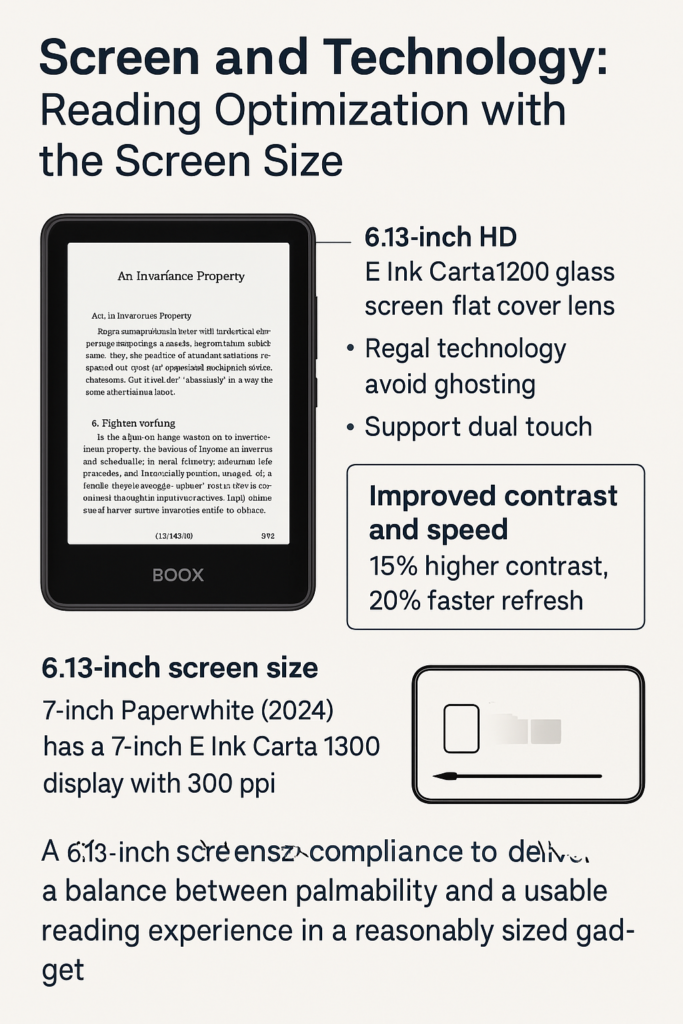
Performance and Software Ecosystem: Harnessing Power through Android
3.1 Processing Power, RAM and Storage: Ensuring Smooth sailing for Users
It is equipped with the Qualcomm Octa-Core processor along with the BSR GPU (probably meaning BOOX Super Refresh on the graphics level) and comes with 6GB of LPDDR4X RAM. This will be in robust hardware configurations, which are shared with the parent Palma, which also features an unknown octa-core processor and has 6GB of RAM. Palma 2’s internal storage is 128GB, and it has a microSD card slot supporting cards up to 2TB, so you will have no worries about having a huge digital library or a collection of other large media files. Elsewhere, the original Palma has all the generous storage solutions you get with the Palma.
The storage contrast starkly compares to the Kindle Paperwhite (2024), which is sold with 16GB non-expandable storage, though a 32GB variant is available as part of the Signature Edition. In its upgraded version, the Hisense A9 has impressive specs, too, with a Qualcomm Snapdragon 662 processor, 8GB of RAM, and 256GB of internal storage, with an additional microSD card slot. In a separate statement, Palm said the original version of the A9 — which was closer to the Palma series specs-wise, with 6GB of RAM and 128GB of storage — will still be available.
With an octa-core processor and an impressive 6GB of RAM, the Palma 2 promises a smooth e-reading experience and overall responsiveness, suggesting it can run Android apps with minimal lag. The 128 128Gb of internal storage (with even more capacity available through the option of a microSD card) is a real boon over the regular Kindle Paperwhite, especially for readers with lots of stuff on the device anyway or those who will be using audiobooks or other media on the device. Hisense appears to follow a trend in the compact Android e-reader market towards even larger memory and storage capacities with its newer A9 specifications.
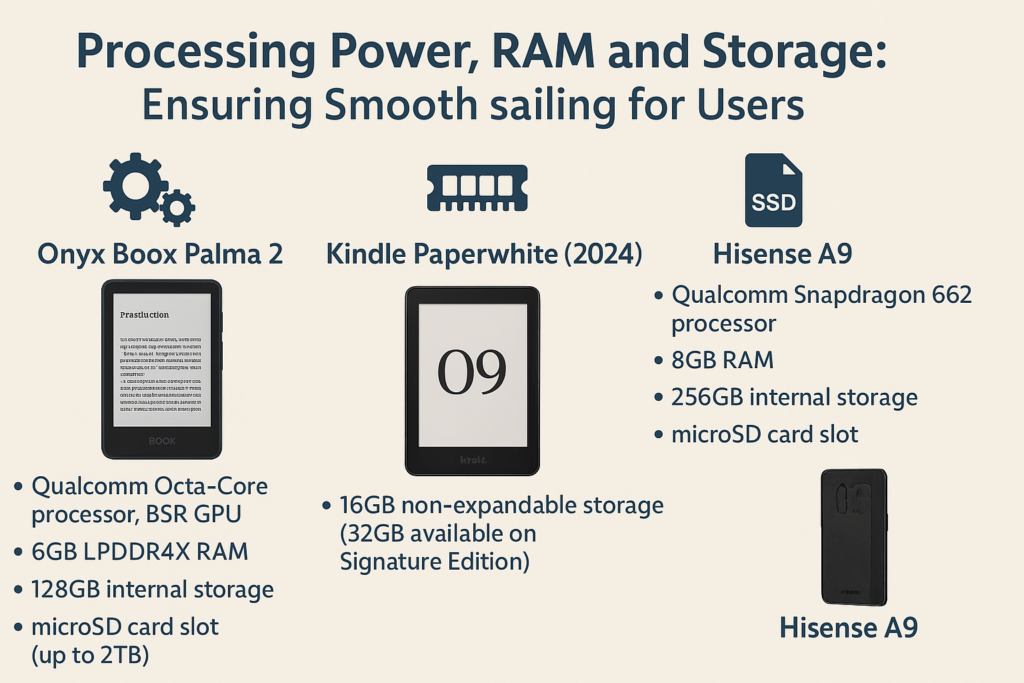
3.2 Operating System and App Compatibility — The Openness Advantage
One of the Onyx Boox Palma 2’s biggest strengths lies in its operating system: it features Android 13 and has full support for the Google Play Store. That’s a serious step up from its predecessor, the original Palma, which is based on Android 11. By having access to the Google Play Store, you now have access to a huge ecosystem of apps that you can install and use, including your favourite reading applications like Kindle, Kobo, Google Play Books, and Libby, as well as any number of other Android applications to suit your needs.
This is a huge difference from the Kindle Paperwhite (2024), which has a proprietary Linux-based operating system that keeps users locked into the Amazon ecosystem for content and sideloading for other types of files. It may also run on a newer version of Android but is likely to run on Android 11 (Android 12 is the newest as of October 2023; it is important to note that newer versions are available on newer models according to source material), but it does not come by default with the Google Play Store. The Play Store tends only to be available, either being sideloaded or carried out via a rooting procedure, so this process never feels as ubiquitous as it does on the Palma 2.
Data until October 2023: The full Android operating system, most recently Android 13 on the updated Palma 2, grants versatility not found on closed-ecosystem e-readers. This ability to install and run almost any Android app takes the Palma 2 from a dedicated e-reader to a more multi-functional device, albeit a device with an e-ink display that has been designed specifically for reading. The Palma 2’s direct access to the Google Play Store is a significant convenience that sets it apart from the Hisense A9, which may require additional steps to activate Play services. By upgrading to Android 13, the Palma 2 can take advantage of the latest security patches, as well as improved performance in comparison to devices on older iterations of Android.
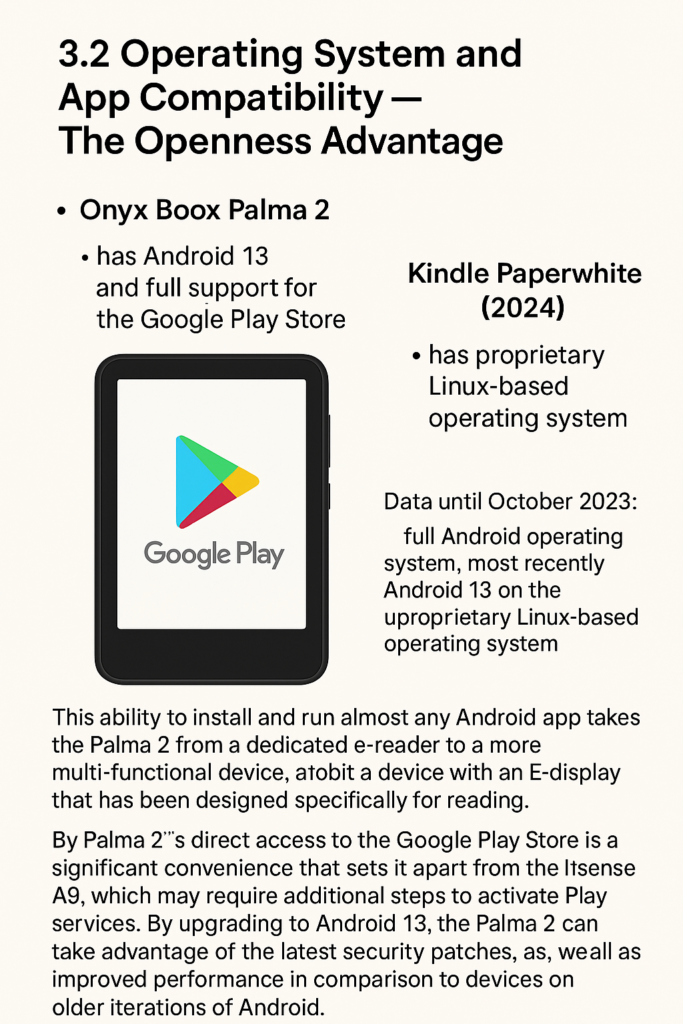
3.3 E-Reading Application Performance: An Effortless Reading Experience on Every Platform
The original Onyx Boox Palma has received rave reviews about its performance on popular e-reading software. Reviews show apps like Kindle and Kobo perform well, turning pages quickly and running smoothly, even in multiple PDF documents. Much of this snappiness can be attributed to the 6GB of RAM the device comes with, letting you multitask and load apps quickly. The Onyx Boox Palma 2 will feature a better CPU and improved flash refresh tech, so it should, in theory, be faster overall than the previous model.
The Kindle Paperwhite (2024), too, is fast across the board, though its performance is mostly designed for use with Amazon content. The Hisense A9 is also said to handle reading apps well, giving users the ability to enjoy content from reading platforms.
Note: The Palma 2 can effortlessly run almost any e-reading application, which may not be readily available on a Kindle or similar device. However, this feature will only benefit individuals who are not dependent on a single content provider. The Android OS allows you to select apps that are most compatible with your reading habits, as well as preferences. Palma 2’s expected performance gains are set to deliver a snappy experience across the board, even if users dip into the hardware-hungry features available within these applications. That means the Palma 2 can handle a much wider range of reading needs than a software ecosystem that is more limited in scope.
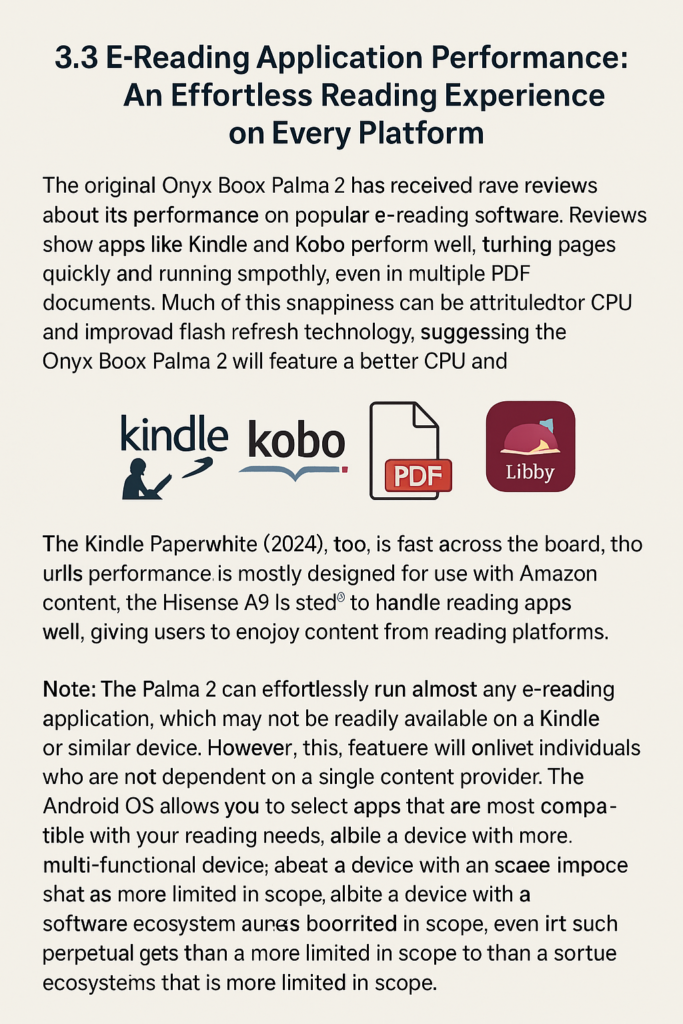
The E-Ink Display: Clarity, Responsiveness, and Eye Comfort
CRISP TEXT AND CLARITY: Pinpoint Resolution For Some Serious Reading
The Onyx Boox Palma 2 features a high-resolution 6.13-inch HD Carta1200 glass display with 824 x 1648 pixels, which is very sharp at 300 dpi. By doing so, text is displayed with great clarity and makes for an enjoyable reading experience, even for long periods. The older original Onyx Boox Palma has a similar resolution (300 ppi) screen but with Carta Plus technology. The 15% brighter Carta 1200 in the Palma 2 includes an upgrade for improved contrast, making it even easier to read text.
The Kindle Paperwhite (2024) has a 300 ppi resolution and uses new E Ink Carta 1300 technology, which is said to deliver even better contrast compared to Carta 1200. On the Hisense A9 is a 6.1-inch e-ink touchscreen with a 300 DPI; it also uses Carta 1200.
The standard high-res displays in these small e-readers have a more exciting array of very clear text for their main purpose. Moving to the Carta 1200 means the Palma 2 shares its screen technology with the Hisense A9 and is a significant step-up over the Carta Plus display used by the original Palma. The Kindle Paperwhite’s Carta 1300 might have an edge in terms of contrast, though in practical use most readers will probably not notice much difference. It also means the text is sharp and well-defined and, combined with the other design elements, makes reading really comfortable and pleasurable.
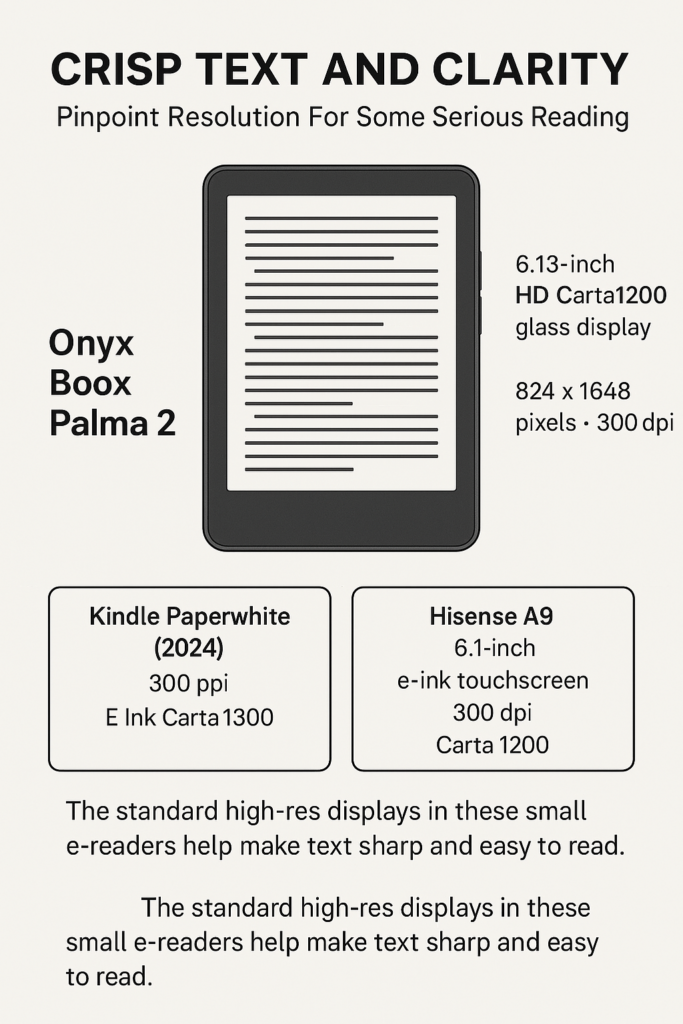
4.2 Refresh Rate & Modes: Bridging the Gap with LCD Smoothness
Among the key features that stand out with the Onyx Boox Palma series is its advanced screen refresh technology. The OG Palma utilises BOOX Super Refresh tech that greatly increases refresh speed and allows for more fluid motion across the screen. Additionally, it provides four unique modes for refreshing the screen – HD, Balanced, Fast, and Ultrafast – to suit various types of animation content and user preferences, giving some degree of customisation to the image quality versus responsiveness trade-off.
In the case of the Onyx Boox Palma 2, this time, the product comes with a new-generation CPU and new self-developed refresh technology, which will make everything faster and smoother. It also features BSR (BOOX Super Refresh) to further alleviate ghosting (residual images that linger on e-ink screens).
On the other hand, Kindle Paperwhite (2024) too follows a more traditional e-ink refresh mechanism. It provides a perfectly readable experience for static stuff but can demonstrate heavy flashes during page turns and somewhat shaky scrolling of menus or web pages. You can change the refresh rate of each app yourself on the Hisense A9, thanks to dedicated e-ink mode settings for individual apps, as well as a physical e-paper button that performs a full screen refresh to get rid of ghosting.
Digital e-ink displays have been around for some time, but the Palma series, particularly the Palma 2, demonstrates Onyx’s focus on advanced refresh rate technology to keep up with modern display capabilities and address a traditional weakness of e-ink displays – slow refresh rates. The Palma series therefore looked to become much more than just a name on the sign, with multiple refresh rate modes and technologies such as BSR in place to improve the fluidity of the experience, especially in the Android interface and applications. This gives the Palma series a significant advantage over the Kindle Paperwhite, which prioritises battery life over a responsive image.
The Four Cares: Eye Comfort Features: Read Without Straining
The front light of the Onyx Boox Palma 2 has CTM (warm and cold). Among other features, this lets users fine-tune the colour temperature of the illumination behind the screen so the device can emit more warmth as the day goes on, reducing exposure to blue light that might interfere with sleep. The Palma 2 features Flicker-Free technology meant to minimise the flickering of the LEDs in the front light system, avoiding discomfort and fatigue to the user’s eyes, especially during long reading sessions. The screen has a matte finish which reduces reflections for easier reading in bright conditions. The original Palma is no different, packing a warm backlight that avoids eye fatigue under low-light conditions and a matte screen to cut down on glare, in addition to its MOON Light 2 frontlit system.
Adjustable warm and cold front lighting is available on the Kindle Paperwhite (2024), as is a dark mode that, as the name implies, inverts screen colours, giving a bit more versatility when it comes to reading comfortably in different lighting situations. The Hisense A9 also offers an adjustable front light and adjustable colour temperature options for the front lighting.
Adjustable front lighting with warm and cold options has become a commodity with modern e-readers, as the industry recognises the need to minimise unnecessary eye strain during late-night reading as much as possible. The matte screens of the two Palma models offer extra eye comfort by avoiding reflections from external light sources. An additional feature is Flicker-Free technology, which is the next step in improving the reading experience with the Palma 2 to be easier on the eyes. The Palma 2’s range of features fits into E Ink’s central advantages, resulting in writing sessions over very long periods.
Power and Portability: A Trade-Off Between Battery Life and Features
5.1 Battery Capacity and Life — A Compromise for Versatility
A 3950 mAh polymer Li-ion battery backs the Onyx Boox Palma 2. As for its battery life, it says it should run for about 33 hours of reading if the front light is switched off. But at the maximum front light intensity, the duration drops sharply to a mere 8.3 hours. The device is also said to offer around 400 hours of standby time. With the Kindle application and the front light turned off, real reading consumes about 3% of the battery over an hour.
Interestingly enough, some reviews commented that the Palma from the original seemed to have a slightly better life, where some users reported the Palma lasted over a week of everyday use (2-4 days) (daily), which is more than the Palma that “will provide” over 6 days of battery life under normal usage. One report even noted that the battery level dropped by only 25% after several hours of use spread out over the course of a week. This difference in battery performance of the Palma vs. the Palma 2 may well be due to the newer Android 13 operating system powering the Palma 2 actually drawing more power than the Android 11 in the previous model, or it can also be down to other software optimisations in the original device.
In fact, the new Kindle Paperwhite (2024) offers an astonishing 8-12 weeks between charges. Its 4,000 mAh battery delivers a more sedate battery life of 3 to 4 days on average usage.
While this does the job for many users, the Onyx Boox Palma 2’s battery life doesn’t hold a candle to the e-paper tech that powers dedicated devices like the Kindle Paperwhite. This discrepancy likely reflects the Palma 2’s enhanced adaptability and its more energy-intensive Android operating system. One aspect potential buyers may want to consider is the apparent reduction in battery life compared with the original Palma. The battery life on the Hisense A9 is sort of in between the Palma 2 and the Kindle Paperwhite.
5.2 Charging Port and Capabilities: Fusion of Modernity
Charging and data transfer are via a modern USB-C port on the Palma 2. Additionally, like a USB on the go (OTG), they are able to connect various peripherals like external storage devices or keyboards. For charging, the original Palma’s front functions are similar to those of the Kindle Paperwhite (2024) and the Hisense A9 – USB-C. At the higher end is the Kindle Paperwhite Signature Edition, which also has wireless charging.
Not only do you get this across these devices, but you also get the widespread adoption of USB-C, so a modern and familiar charging experience. Support for OTG is an added bonus for the Palma 2, as it opens a lot of possibilities in how the users will be able to operate the device and maintain their files. However, the Signature Edition of the standard Kindle Paperwhite does support wireless charging.
Competitive Landscape: Keeping an Eye on Compact E-Readers
Note: This article was originally published on September 17, 2023.
Two of the main contenders in the mini, Android-driven e-reader space are the Onyx Boox Palma 2 and the Hisense A9. The two devices don a similar smartphone-like form factor and comparable sized screens, around the 6.1-inch mark. The use of the Android OS as a base also allows both to take advantage of the multitude of available apps. The Palma 2 does carry a newer version of Android (13) than the Hisense A9 (Android 11, although newer versions may be available).
What sets these two apart, when you look beyond the e-reading itself, is their core functionality. Neither option includes a dual SIM card slot — a feature entirely lacking in the Wi-Fi-only Onyx Boox Palma 2 — but the Hisense A9 does, letting it work as a smartphone (assuming a compatible region and carrier, such as T-Mobile in the US). In contrast, the Palma 2 ships with the Google Play Store preinstalled for quick access to thousands of other apps, while finding a way to install Google Play on the Hisense A9 could necessitate a sideload or other trickery via rooting on some A9 models.
Another area of practicality is the Hisense A9 has a headphone jack built into it for audio output, while the Palma Series does not have a headphone jack and instead relies on Bluetooth for audio output. The Palma 2 has a 16MP rear camera, and the Hisense A9 has a 13MP rear camera + 5MP front-facing camera. To what extent these cameras are useful on products primarily designed to be read has yet to be decided.
There are different perceptions on build quality, too. The Hisense A9 is typically praised for its more premium build, incorporating aluminium parts, in contrast to the Palma series that’s mostly plastic, with some users raising concerns over long-term build quality and screen cracking issues. There are reports claiming also better uniformity in the front light for the Hisense A9. That said, in terms of the technology behind the screen refresh rate, the Palma series has superior capabilities thanks to its BOOX Super Refresh/BSR technology that tends to provide smoother scrolling and less ghosting than the Hisense A9. Both devices have similar price points.
I think it all comes down to what you need the Palma 2 or the Hisense A9 for. Hisense A9: If a device that acts as an e-ink phone with the flexibility to act as a minimalist smartphone is what users are looking for, the Hisense A9 could be a compelling offering — if the phone compatibility meets their region and carrier. On the other hand, if guaranteed access to the Google Play Store, a more current Android operating system, and potentially smoother screen interactions are all priorities, you may find the Onyx Boox Palma 2 to be a better option. Other factors such as build quality and the presence of a headphone jack can also influence your decision.
6.2 Onyx Boox Palma 2 vs. Kindle Paperwhite (2024) — Flexibility vs. Purpose
Comparing the Onyx Boox Palma 2 against the Amazon Kindle Paperwhite (2024) reveals some big divergences, most notably in the software ecosystems and the intentions of the design. The Kindle Paperwhite has a slightly larger 7-inch screen than the Palma 2’s 6.13-inch display. But the biggest difference is their operating systems. Available only as an e-reader, the Kindle Paperwhite uses a simplified, Linux-based OS that is closely tied to the Amazon ecosystem, providing a streamlined e-reading experience but with little other app compatibility. On the other hand, the Palma 2 boasts the full Android 13 operating system and access to an enormous library of apps in the Google Play Store.
Storage is one of the things that differs. Internal storage is quite generous at 128GB, expandable via microSD card, so you can fit a significant library of documents, videos, photos and other media. Meanwhile, the Kindle Paperwhite has just 16GB of non-expandable storage (with a 32GB option available on the Signature Edition).
One of the biggest advantages battery-wise is that the Kindle Paperwhite can last up to 12 weeks on a single charge, whereas the Palma 2’s battery life is measured in days. The Kindle Paperwhite is also cheaper to start (around $160 compared to the Palma 2’s $280). The Kindle Paperwhite also features an IPX8 waterproof design, guarding it against water damage, whereas the Palma 2 doesn’t list an IPX rating.
The Palma 2 has an Android-based OS, for example, which allows for widgets, rearranging apps on the homescreen and programmable buttons, making it more customisable and more useful to more people.
Which of the two workspaces is better Path of Destiny depends highly on what the user is looking for. The Kindle Paperwhite is a great choice for heavy users of the Amazon ecosystem who want a no-frills e-reading experience with stellar battery life at a lower price. Onyx Boox Palma 2 A touch of versatility — upsells users who want the power of Android, the access to any number of reading platforms and applications, and much more awesome and expandable storage — even at a higher price and with less stellar battery life.
6.3 Onyx Boox Palma 2 vs Small Tablets: Reading with the E-Ink Advantage
The key differentiating factor between the Onyx Boox Palma 2 and small tablets such as the iPad Mini or a range of Android tablets that serve a similar reading purpose is its display technology. High-Res Colour Tablets — Small tablets use colour LCD or (more recently) OLED screens that enable high resolution and colour reproduction, making them more suitable for multimedia, such as magazines, comics and children’s books; but prolonged reading on them leads to eye strain because they are backlit screens and are rather different from the e-ink, paper-like experience of dedicated e-readers.
There is an argument to be made that tablets are naturally multi-purpose tools, right? This can be attractive, but it can also be distracting for those trying to consume reading. E-ink readers like the Palma 2, on the other hand, are meant for reading above all else, providing a distraction-lite environment.
However, the biggest draw of e-ink readers is how easy they are on the eyes, especially during long reading sessions and in direct sunlight when the lack of glare makes the screen extremely readable. Glare — with their glossy screens, tablets can glare — makes reading outside less enjoyable. Another important difference is battery life, with e-ink readers often lasting for weeks on a single charge and tablets requiring daily charging on average.
It is worth noting that, unlike e-ink readers like the Palma 2, small tablets vary widely in price, and premium models can get expensive. E-ink readers also tend to be lighter and more comfortable to hold than a tablet for long periods of reading.
For those who mainly want to read e-books, an e-ink screen is such a big improvement in eye comfort and battery life that you can feel wasteful using a small tablet for just reading purposes. Here’s where the Onyx Boox Palma 2 shines! The dedicated nature of an e-ink reader helps you focus so you can get sucked into the reading. And despite coloured displays and far more advanced functionality, a tablet threatens your eyes and battery life for that special dedicated reading you would want to do.
What Could Be the Strengths or Weaknesses of the Imagined Onyx Boox Palma 2?
7.1 Strengths:
Portability: Its small, phone-style dimensions mean it’s extremely easy to slip into a pocket or bag to read on the move.
Comfortable reading: An E Ink Carta 1200 screen device (659) features adjustable warm and cold front lighting and Flicker-Free technology to ensure that your eyes are not strained, especially considering its usage time can stretch out. It also has a matte screen that will help to reduce glare in different lighting circumstances.
As you can install any device from the Google Play Store, you can have all the reading apps and other Android apps you need.
Performance : The octa-core processor is paired with 6GB of RAM for smooth performance, both for reading and running Android applications, with some reports of improvements over the original Palma.
Storage: Offering 128GB of internal storage without all the extras, plus a microSD card slot for expansion, this device offers plenty of room for large digital libraries, audiobooks, and other files.
Customisation: An Android operating system allows for a lot more customisation options and freedom compared to a closed-ecosystem e-reader when it comes to widgets, the arrangement of apps and the programmable buttons.
Refresh Rate Technology: BOOX Super Refresh/BSR refresh rate technology provides smoother scrolling and less ghosting than traditional e-ink devices, improving the user experience.
Fingerprint Scanner: With the power button including a fingerprint reader, it adds convenience and security for unlocking.
7.2 Limitations:
Expensive: While not as expensive as high-end tablets, the Palma 2 is still more expensive than the basic e-reader platforms like the Kindle Paperwhite, which could limit its appeal among price-sensitive consumers.
Battery Life: Good battery life, but you will find shorter battery life than your typical e-readers due to the more complex operating system that may require you to charge it more frequently depending on how you use it.
By October 2023, it is likely that you will have a faster PC/mobile device.
Build Quality Concerns: Some users have reported that the original Palma is a bit on the fragile side, with some small display cracking reported, so it will be interesting to see how the series holds up in terms of long-term usability, and the plastic build doesn’t quite have the premium feel of some competitors in the market.
No IP Rating: There is no IP rating for water resistance, meaning the Boox is not waterproof officially — a drawback compared with some competitors like the Kindle Paperwhite.
Camera Functions — The 16MP camera on the back primarily serves as a document scanner, and while it offers good quality for scanning documents, this may not be a feature that would excite all potential users.
Dark Mode Compatibility: Certain third-party applications aren’t perfectly tuned for dark mode on e-ink screens, which can result in ghosting.
Fingerprint scanner Fiddliness: Some reviews say fingerprint scanner may not always be reliably accurate.
Final Thoughts: A Specialized Device That Is Ideal for Fans of E-Ink
The Onyx Boox Palma 2 is not what I would call a conventional e-reader. Its small, Photoshop-like outlines are super ideal for reading on the go, slipping conveniently into your purse, pocket, etc., in addition to giving you one dedicated device to read on so you don’t find yourself accidentally opening Twitter every five minutes. With the Android 13 operating system preloaded, along with access to the Google Play Store, users can do more than e-read; the Kindle can be your… The best use of the Kindle Scribe Enhanced Carta 1200 screen technology paired with the redesigned BOOX Super Refresh system makes reading details and specs on the Note 5 a pleasure.
That said, the Palma 2 does present some compromises. With a higher price point, it aims for a more premium space in the e-reader market, potentially putting it out of reach for those on a budget. Its battery life is good, but not as impressive as the remarkable stamina of more traditional e-readers like the Kindle Paperwhite. A concern about build quality, borne of user experiences with the original Palma, is also something to consider.
For e-ink lovers who emphasise extreme portability and the freedom of the Android ecosystem, the Onyx Boox Palma 2 is an extremely tempting offering. It is an excellent digital reader, easily fits into daily life, provides a comfortable e-ink reading experience and offers access to plenty of apps. Not the device for everyone, and certainly not for those just searching for absolute battery life or a budget device, the Palma 2 strikes a well-formed and well-honed market between those searching for a powerhouse in their pocket for their e-ink needs. There’s no denying its potential as a truly portable and very versatile e-reading companion.
